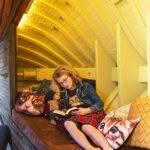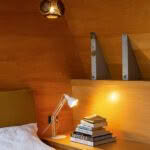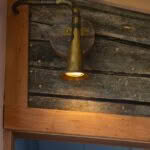A fishing boat-turned-tiny house gets a new life on the shores of the Whanganui River

Approaching a century old, the Iona lies high and dry on the eastern bank of the Whanganui River. Her working days may be behind her, but this beautiful fishing boat is far from washed up.
Words: Lee-Anne Duncan Photos: Tracey Grant
For most boats, a 90-degree list signals an end to a useful life. In the case of the Iona, it is just the opposite; she has been reborn as a tiny house. The little vessel’s latest voyage has been captained by Whanganui architect Elinor Harvey McDouall, who designed the mod cons that have been squeezed into the boat’s tiny spaces and curved lines and navigated any challenging nautical lingo.
“You learn a lot from every project, but this one more than most – especially the vocabulary, as the guys working with me used boat language.”
Elinor knew nothing about boats beyond admiring their curves when dry-docked. “When a boat is in the water you can’t see the beauty of it, the best bits. Making a boat into a building is the chance to show it as a sculptural piece, even art. It’s certainly a work of craftsmanship.”
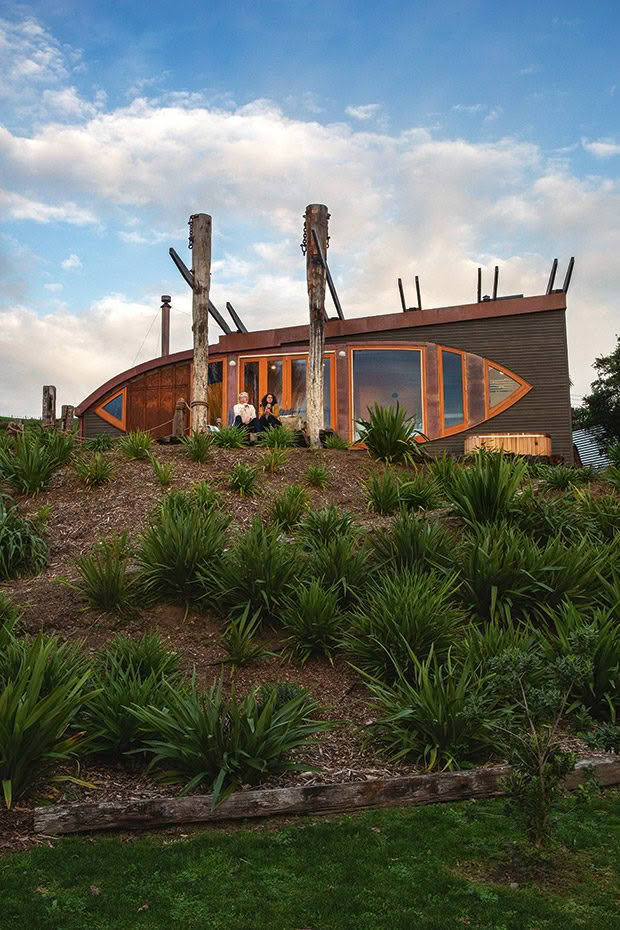
The Iona is no longer on the water — she is now secured on her side beside it.
It took Elinor four years to get the Iona project to the point where the architect could launch what’s likely to be Whanganui’s most intriguing accommodation. While she and her family – two children, Bede (13) and Elise (11), and husband Hamish, who’s also the city’s mayor – love hanging out on the Iona, the boat is also open to holidaymakers keen to fold themselves into her 36 square metres – or 57 square metres if her deck is included.
Inside, the Iona has everything one expects – a bathroom, full kitchen, lounge and double bedroom, with a single berth hidden away. There’s even a fridge and microwave tucked under the bench, and a miniature log burner to keep visitors cosy. While the Iona looks very settled – and has an expansive view of the Whanganui River – Elinor has designed her so she can up anchor and set (metaphorical) sail for another site if required.
Elinor spent about three months, in between other projects, creating meticulously detailed drawings and plans to ensure the Iona’s redesign would work. This included incorporating (and hiding) the boat’s steel structure and eight-metre piles, arranging everything to fit, and convincing the local council to consent her project.
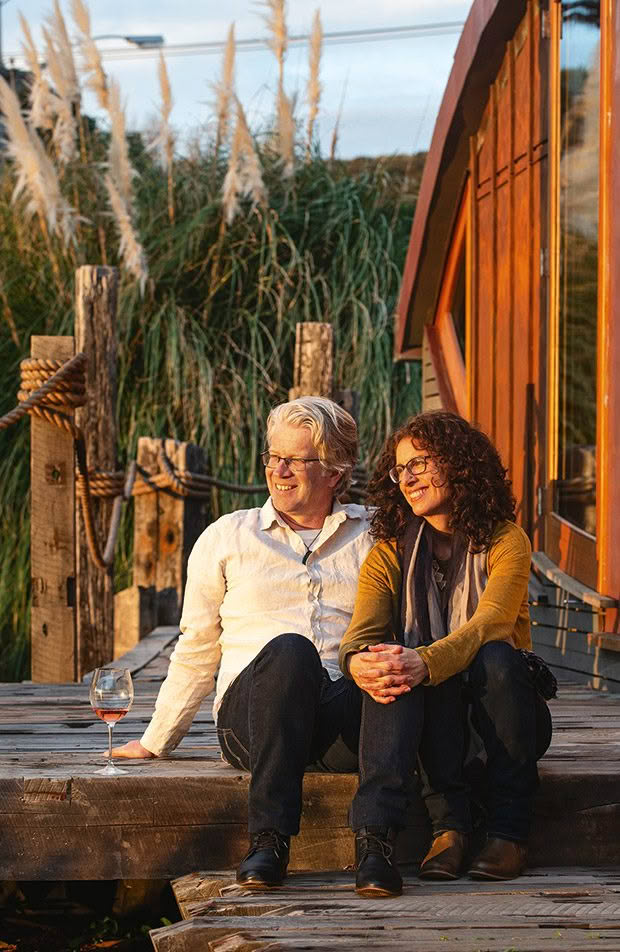
Architect Elinor Harvey McDouall (pictured with her husband, and Whanganui’s mayor, Hamish McDouall) has reincarnated the former fishing boat’s hull into a living space. What would have been the Iona’s deck is now fitted with curved windows — quite the challenge for Elinor’s joiner — which look out onto the Whanganui River.
It’s quite the accomplishment, considering it all started with an internet trawl.
“When I get into a certain mood – maybe the winter blues? – I spend ages sifting through random stuff on Trade Me. The Iona’s hull popped up for sale, and I felt drawn to her. I don’t know why. I wasn’t at all interested in her as a boat. I just thought I could do something with her.”
Luckily, husband Hamish McDouall (some might remember him as the fresh-faced student who won television quiz shows Mastermind and Sale of the Century 30 years ago) was right behind her.
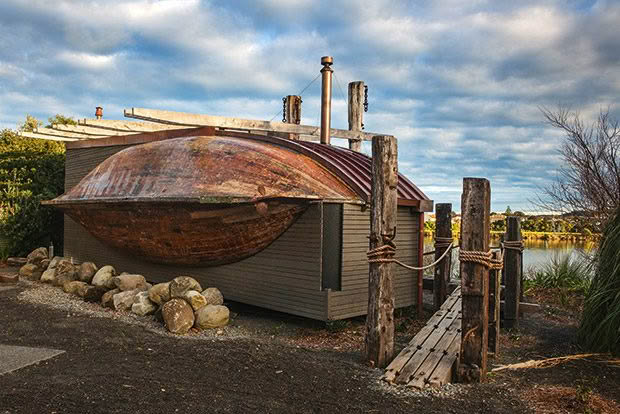
The river site might seem like a given, but Elinor says she originally wanted to insert the Iona into the “urban fabric” but realized she was unconsciously designing the boat to sit by the river.
“Elinor just said she’d found this boat and wanted to buy it. When she started talking about converting it, it seemed like a long bow to draw considering the size of the boat, but suddenly these designs and beautiful sketches started emerging, and I thought, ‘I get it.’ It was a bit of a leap of faith, but I have immense confidence in Elinor’s vision. She sees the beauty in things and can find the utility in them.”
Much of Elinor’s work during her 20 years as an architect has involved renovating houses or Whanganui’s historic buildings, including some built by Clifford Hood, an architect great-uncle she never knew she had until she moved to the city a decade ago.
“Renovations aren’t always considered desirable work for architects, and they certainly can be difficult and time-consuming. Over the years, I’ve worked out it’s the transformation from ugly and inefficient to beautiful and functional that fires me as a designer. Recently, I’ve been focused on the adaptive re-use of heritage buildings – transforming them into something new.”
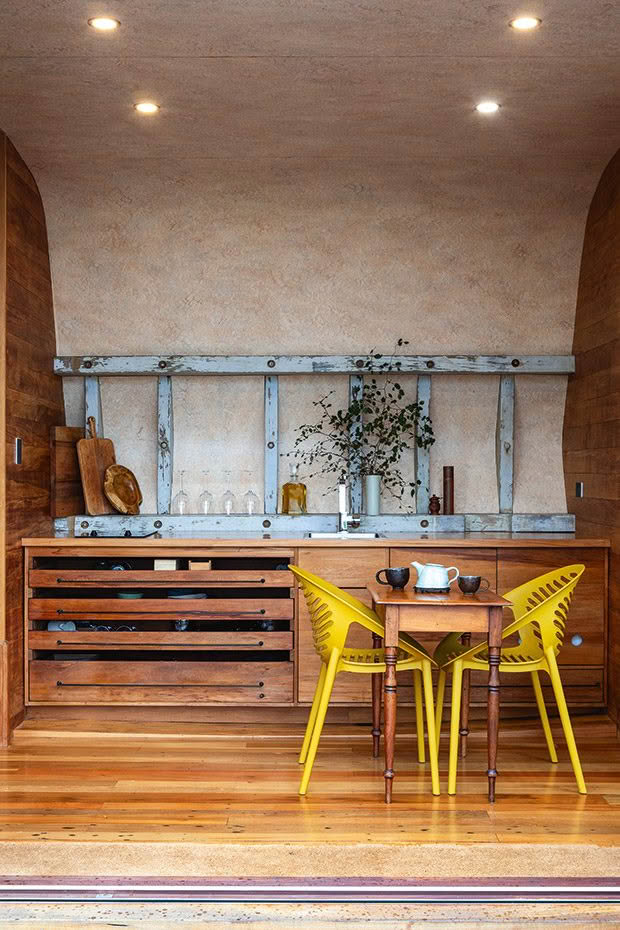
There was no room for error in the Iona’s design, especially in the kitchen, where the hull “shrinks down to nothing”. The material on the kitchen ceiling is Marmoleum, which is designed for floors, but Elinor had a different vision. “It has great qualities and looks quite leathery, so to me, it lends itself well to the boat theme and the timber”.
Iona’s renovation, restoration, resurrection, reincarnation – whichever, or all four – sparked more interest from her kids than previous projects. While watching George Clark’s Amazing Spaces, Bede and Elise would ask their mum to do “cool and interesting” work like that.
“And I agreed with them. I feel like we’ve lost a lot of the magic, the joy with our spaces. When I went through university, everything had to be black and cool, with little ornament, and it certainly wasn’t done to have things like kids’ art on fridges. I never believed that’s the way we’re meant to live. Where’s the joy and fun in that? This project is a response to that, I think. The boat gives joy.”
Joy, certainly now, looking at the Iona, with her richly brown kauri and tōtara, and copper that gleams in the sun; with her river-facing deck of trusses salvaged from the old Wanganui Majestic Theatre, which was demolished in the 1970s, and supported by posts from Wellington’s wharf.
- While some tiny-space designers are tempted to add “fold-away gizmos” to save room, Elinor says she didn’t want to put people to the hassle of hiding away frequently-used furniture, such as the table, and the sofa where daughter Elise (11) lies.
- Revamping the boat gave Elinor a chance to use the bits and pieces she had collected over the years, including this perforated coconut husk.
- A vintage car airhorn. Elinor pays tribute to the skills of the tradesmen who fabricated the fittings necessary to turn both of these long-lugged-around finds into functioning lights.
Most of the materials Elinor used were reclaimed, including the kauri and jarrah repurposed from the Iona’s cabins and gunwale, and the rimu sarking and match-lining salvaged from other projects and demolition yards. People intrigued with her project helped by donating materials or parts.
Elinor is drawn to reclaimed products for sustainability reasons and also because they’re beautiful and of a quality now unobtainable. The meld of old and new allows the Iona, with her copper roof, picture windows and curved timber joinery, not to “read” as new, remaining true to her centenarian status.
Reimagining materials also makes Elinor remember “mucking about” in her furniture-maker father’s shared workshop at the bottom of Auckland’s Parnell Road, constructing creations from his offcuts and those of the other artisans – ceramicists, woodturners, kite makers and, yes, a boat builder.
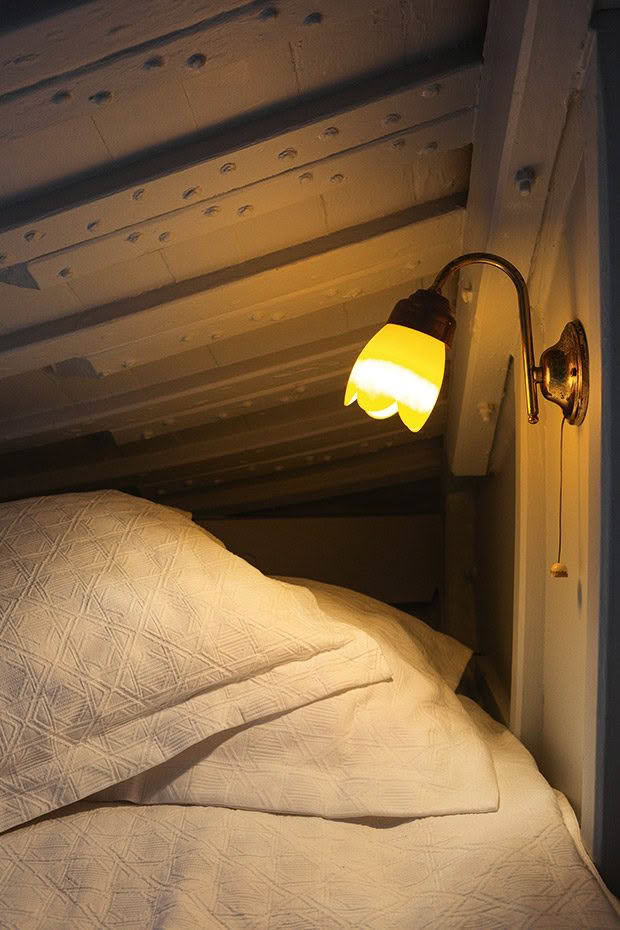
Working largely with old timbers, reclaimed bits and pieces and repurposed materials might seem like a tradie’s nightmare, but Elinor says the build gave the craftspeople with whom she worked joy, too.
“I was delighted and energized by using my creativity for my own project, but I think the craftsmen who worked with me also felt that way. A tradesman’s job can be quite repetitive, and by a certain point in their career, they’ve seen it all. I was lucky to find great guys to work with. But I think they did a particularly wonderful job because they were interested in the project. They understood what I wanted to do and – like me – thought every problem was fun to solve.
“It was hugely important to them to get everything right. For example, when the Iona arrived, she had a rudder but no propeller. It never occurred to me, but every single male immediately noticed and said, ‘We have to get a propeller.’ Luckily, a local donated a propeller, which a friend then installed.
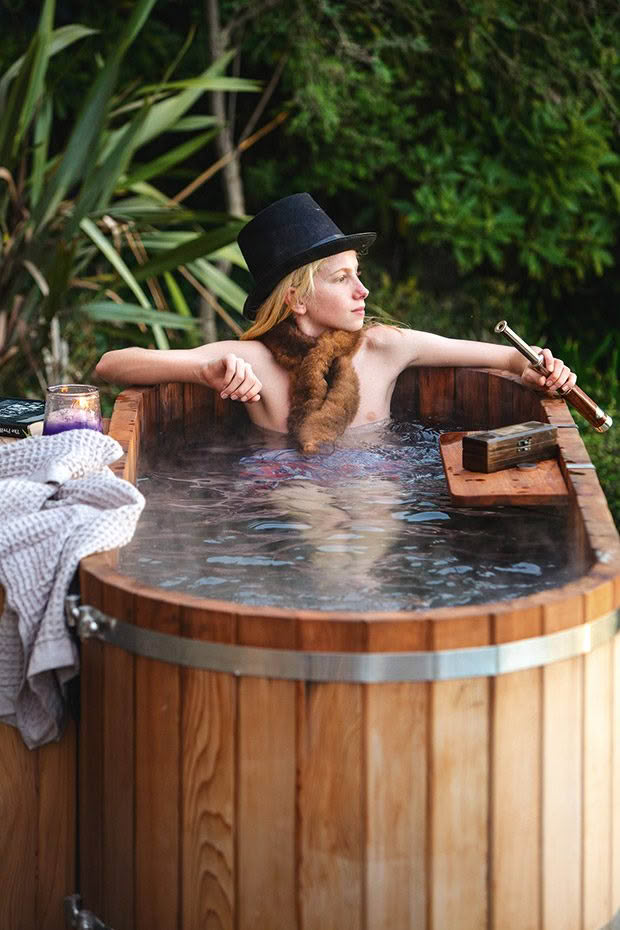
The two-person spa, warming up son Bede (13), is from Alpine Spas in Christchurch.
“Another example is that after the hull was placed, the stern twisted 14 centimetres out of alignment in a few weeks. The engineer then knew that a steel connection to the old rudder stock – a post once used to brace the rudder – would be an incredibly effective way to brace the whole hull. It worked perfectly.”
There were times when a little more knowledge may have saved Elinor some of her own hard work. When the Iona arrived, shipped down from Whangateau, north of Auckland, she was heavy with a slurry of water, diesel and goodness knows what else.
“The water was up to my knee. I was inside, bailing it out with a bucket for ages. Then a friend arrived with her mechanic husband who said, ‘There must be a bung in here somewhere – yep, here it is.’ And with that, he reached down, pulled out the bung and the slurry ran out onto the ‘hard’, as they say.”
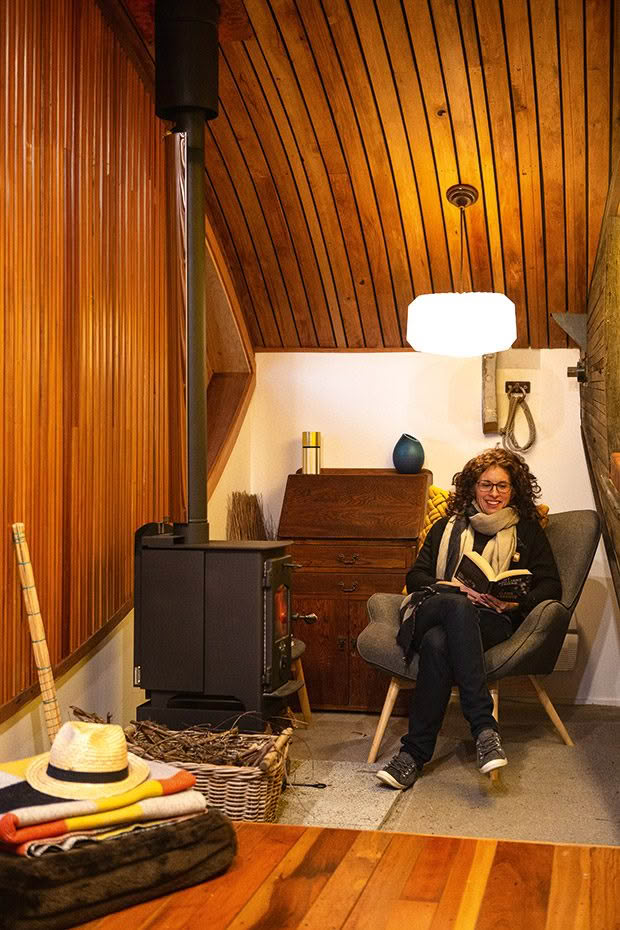
Recycled wharf piles and heavy ropes give the Iona’s entrance and decking a nautical theme, but Elinor deliberately changed the tone inside. She wanted it to be warm and comfortable, an atmosphere fueled by the mini woodburner from Wagener Stoves in Kaitāia.
The Iona’s decrepit days are long in the past. Now, her new arching windows spread like a smile as she gazes across at Whanganui’s CBD and watches the passing river birdlife and river craft – including waka ama outriggers, kayaks and Whanganui’s famous paddle steamer, the Waimarie. While the Whanganui River tends to flood, Elinor laughs when asked if the Iona may one day find herself once again afloat.
“The floor plane is five metres above the 100-year flood line, so the whole town would have to be underwater for her to be in danger. But many people have joked about that.”
Whether the river is a little too close for comfort or not, it’s undoubtedly a dominant feature in the town and enjoys the legal status of a person. As the mayor, Hamish says he’s delighted his wife’s project is another link between visitors and the river.
“The Iona is only five minutes’ walk from downtown, so it’s great to have an eccentric and beautiful piece of boutique accommodation so close. We have quite a few projects like that in Whanganui, with buildings being utilized in different and quite edgy ways. It’s the right infrastructure to go alongside our arts culture. Together, it creates an innovative and creative vibe in Whanganui.”
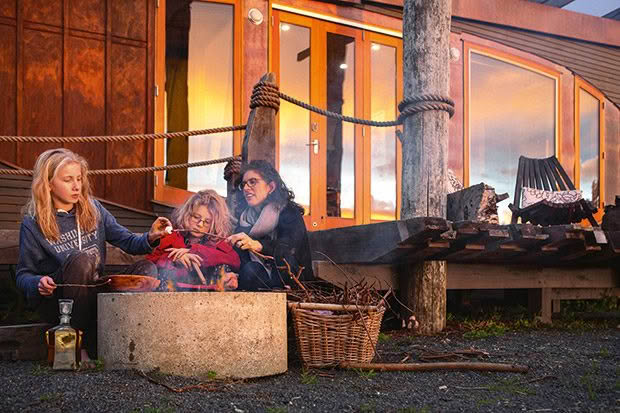
As for any suggestion that Elinor enjoyed an easy ride from the council’s building team: “We had a senior inspector on it because it was such an innovative project, and I think the team were possibly a bit harder on her,” says Hamish. “In my experience, being related to the mayor does you no favours, and neither it should.”
Looking back on all the challenges, Elinor’s hardest was pressing “go”.
“I was doing something rash, and I’d been brought up not to say, ‘Let’s all do what I want’. Here was I, about to do just that, while risking my family’s money. The pressure for it all to work out was tremendous. “At the same time, after 20 years as an architect, I was confident it would work overall, even though quite a few of the details were still a bit fuzzy. Anyway, those grey areas on a project are all part of the fun.”
96 YEARS AND COUNTING
The Iona was built by Miller & Tunnage, Dunedin, and launched as the Mona in 1924, first fishing out of Akaroa and later Moeraki. In 1941, the Otago Harbour Board bought her, using her as a lines boat and to service the harbour entry lights at Port Chalmers, a twice-daily job.
She was sold 37 years later and restarted her fishing career. But after an accident on Otago’s Taieri River, she returned to Miller & Tunnage for extensive work on her stern, frames, and planking, before popping up in Whāngārei in the 1980s, again as a fishing boat.
She was then stored for some years. Her previous owner had been preparing to restore her to her original configuration with two masts and a wheelhouse towards the aft (stern/rear), but he is reported to have run out of energy, allowing Elinor to take the helm.
OUT AND ABOUT IN WHANGANUI
For a small city, Whanganui has more than the usual number of curious and creative places to see, things to do and places to stay.
New Zealand Glassworks: In the squat Old Chronicle Building, glass artists have created a gallery and studio space that positively glitters. Visitors can shop (carefully) and even book in to learn how to blow their own creations. Also within the building,
Article Café, brings together more of the city’s quirky visual art, vintage clothing, and gifts for sale.
St Paul’s Memorial Church: A traditionally beautiful wooden church from the outside, St Paul’s interior is splendid, with magnificently intricate Māori carvings and meticulous tukutuku panels. Together, they share the story of the area dating back to the 1830s.
Quartz Museum of Studio Ceramics: The brutalist grey exterior of this building gives no clue to the array of fantastical colourful ceramics inside. The ceramics are the work of artist Rick Rudd and the museum features more than 400 of his and others’ creations, including his famous teapots.
Durie Hill Underground Elevator: Beyond the City Bridge, Durie Hill’s 213-metre long pedestrian tunnel leads to the historic Durie Hill Underground Elevator. Built in 1919, it is New Zealand’s only public underground elevator.
Whanganui Musicians Club: This music venue, in the now-defunct local Savage Club, is the place to listen to music over a few BYO beers, especially during each First Friday club night held, as expected, on the first Friday of every month. It looks like every New Zealand community hall from the outside, but the décor still features the eccentricities of its Savage Club days.
Mountains to Sea Cycleway (Ngā Ara Tūhono): Whanganui signals the end of this five-day trail ride, which begins up on the volcanic plateau and finishes after wheeling past the Iona herself, down to the Tasman Sea.
MORE HERE
Japanese Furoshiki: An eco-friendly alternative to paper gift wrapping
Take a tour of furniture designer Ed Cruikshank’s alpine home and studio in the Queenstown Basin
Love this story? Subscribe now!
 This article first appeared in NZ Life & Leisure Magazine.
This article first appeared in NZ Life & Leisure Magazine.
